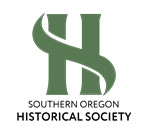(Written by Kira Lesley) As the archivist of the Southern Oregon Historical Society, I was thrilled by the prospect of this donation, and at the time, knew nothing about William Gruber except that he invented the View-Master. A staff member and a society volunteer rented a U-Haul and drove 425 miles to pick up the collection. The heavy negatives, spread across approximately 70 wooden boxes, weighed approximately two tons. The donor explained that the plates had been located at Sawyer’s, but that the collection also contained plates from the Kiser studio, which produced many postcards of Crater Lake. Unfortunately, we do not know for sure which plates were came from which studio, or who the actual photographer was. Perhaps the more we work with the images, and the more research we do on the Sawyer’s company, we will better be able to decipher which is which.
Based on the clothing of people in some photos, we estimate that most were taken in the 1920s and 30s. However, when I began unloading the photos, I found a different set of plates, that appeared to depict the Boston area around the turn of the 20th century. The origin of these plates is currently a mystery. These images were stored in cardboard boxes within the wooden boxes, and as I unloaded the smaller boxes, I was shocked to see swastikas printed on the side. Knowing that the swastika was a fairly common decorative symbol prior to its adoption by the Nazi party, I thought perhaps the symbol was purely decorative, and probably pre-dated the party’s adoption of the symbol in 1920. I also began googling William Gruber, and quickly discovered that he was, indeed, a member of the Nazi party, and though he denounced Hitler later in life, I began to wonder if the materials I’d just accepted were related to Naziism, and if so, in what way.
At this point, I do not know where the boxes with the swastikas came from, though due to their age, I do not suspect they have any link to the Nazi party. The contents of the Boston-area boxes are street scenes, and they appear to be from the first decade of the 20th century. The rest of the collection is largely scenic, with views throughout Oregon and the West.
In recent years, museums have begun to reckon with the question of how best to accept donations from problematic donors. However, this conversation has largely focused on monetary donations. In addition, the issue of whether or how to display an object that was obtained through unethical means has been around for decades (thought not resolved) and many museums and archival collections have worked to return Native American artifacts, for example, to their Native communities (though again, much more work can and should be done in this realm).
The issues raised above did not seem to apply here. This donation was not monetary, and the images themselves were not stolen artifacts, though one could argue that the existence of scenic photos depended on this displacement, and death, of Native people. Some great conservationists were guilty of erasing Native peoples from their descriptions and representations of the land altogether.
In assessing how to handle this donation’s connection to Naziism, I felt it was important also to remember that the donation was not gifted by William himself and the contents are scenic, completely unrelated to Hitler, Naziism, or WWII. The collection contains important images, particularly in the field of environmental history, and should be made publicly available. At the same time, I believe the connection to Naziism, though indirect, should be mentioned. The story speaks to our current societal interest in reevaluating how to display and interpret complex histories, including ones that are connected to ideologies or actions that most contemporary Americans roundly denounce.
The negatives themselves contain scenes from several national parks, including Crater Lake, Yellowstone, Yosemite, and Glacier. These images provide a time capsule of our environment approximately 100 years ago. As the landscape rapidly changes, including the shrinking of glaciers at Glacier national park, these images will continue to provide important historic records. Further, both Kiser and Sawyer’s studios were influential in developing Crater Lake and Glacier as national parks.
Finally, the images provide fascinating historical records about white Americans’ interactions with Native Americans. Particularly interesting are the images involving Chief Bighorse, a member of the Blackfoot nation who was employed in tourism surrounding Glacier National Park and the Great Northern Railway.
